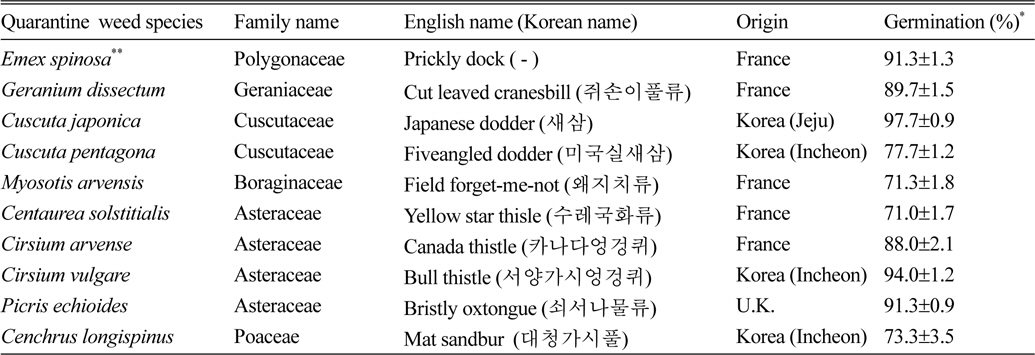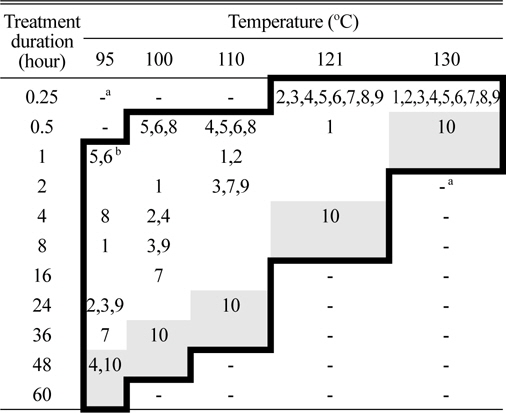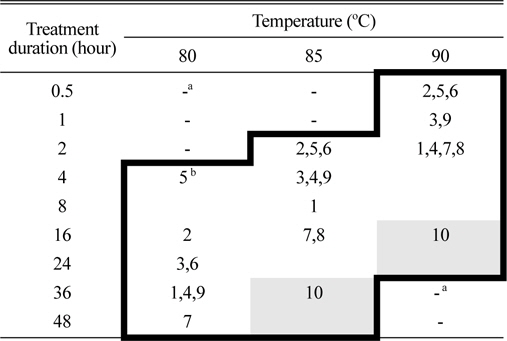



Korea is carrying out weed quarantine by plant quarantine regulations including heat-treatment method to prevent the influx of exotic weeds. In order to confirm suitability for current heat-treatment criteria and find field-applicable methods which can completely devitalize quarantine weed seeds, the conditions for heattreatment with/without 40% relative humidity were studied with 9 species among quarantine weed seeds and one weed species similar to quarantine weed. Dry heat-treatments had been tested under various temperatures and time conditions. All seeds were dead at the conditions of 95℃ for 48 hours, 100℃ for 36 hours, 110℃ for 24 hours, 121℃ for 4 hours and 130℃ for 30 minutes. Heat-treatments at 40% relative humidity resulted in complete seed death at the conditions of 85℃ for 36 hours and 90℃ for 16 hours. The above results show that current heattreatment criteria are not suitable for several quarantine weeds and these conditions could be applied as a quarantine method to prevent the influx of quarantine weeds along with agricultural imports. More specific conditions for heat tolerant species such as
우리나라를 비롯한 세계 여러 나라는 수입식물을 통하여 유해한 잡초가 유입되는 것을 방지하기 위하여 검역을 실시하고 있다. 우리나라는 3개속 17종의 검역잡초(Quarantine weeds)를 지정하고 있는데(QIA, 2012) 식물방역법상 검역 잡초는 식물의 수입과정에서 ‘소독·폐기 등의 조치를 취하지 아니할 경우 식물에 해를 끼치는 정도가 크다고 인정되는 것’ 중 ‘국내에 분포하지 않거나 국내 일부지역에 분포하더라도 발생예찰 등의 조치를 취하고 있는 잡초’를 말한다(MIFFAF, 2012a). 이러한 검역잡초가 혼입된 화물은 폐기, 반송, 선별, 가공처리 등의 조치를 통하여 국내 유입을 차단한다(MIFFAF, 2012b). 이 중 가공처리는 열처리, 특수가공처리, 압착 또는 분말처리 등이 있으며, 열처리는 비재식용 식물의 물리적인 변화를 최소화하면서 발아력을 제거하는 효과적인 방법으로서 우리나라를 비롯하여 미국, 호주, 뉴질랜드 등 검역선진국에서 이용되고 있다.
우리나라의 열처리 기준은 100℃에서 30분 이상 또는 121℃에서 15분 이상 처리하는 건열처리와 85℃에서 15시간 이상 처리하는 습열처리(상대습도 40%)를 적용하고 있는데(QIA, 2011), 현재의 열처리 기준은 각종 문헌, 외국의 검역기준 등을 참고로 마련된 것으로서 국내에서는 검역잡초종자의 사멸과 열처리에 대한 구체적인 연구가 매우 미흡한 실정이다. 다른 나라의 열처리조건을 보면 미국과 캐나다는 120℃에서 15분 이상의 건열처리(CFIA, 2001; USDA, 2010), 호주는 상대습도 50%로 85℃에서 48시간 이상 또는 95℃에서 24시간 이상의 습열처리(AQIS, 2008)를, 뉴질랜드는 상대습도 40%로 85℃에서 15시간 이상의 습열처리(MAF, 2010)를 적용하고 있어 우리나라와 유사하지만 약간씩 다른 조건을 적용함을 알 수 있다. 개별적인 국가의 검역환경이 조금씩 다르고 지정된 검역잡초에 있어서도 뉴질랜드 286분류군, 미국 97분류군, 호주 88분류군, 캐나다 7분류군 등(IPPC, 2010)으로 3속 17종이 검역잡초로 지정된 우리나라와는 검역잡초의 종류 및 종자의 내열성정도가 다르기 때문에 그에 따른 열처리기준도 다를 수 밖에 없다. 따라서 검역잡초의 발아력을 사멸시키기 위한 열처리기준은 그 나라에서 규제하는 검역 잡초를 이용한 과학적인 실험을 통하여 규정되어야 할 것이다.
이에 우리나라 검역잡초의 발아력을 완전히 제거하기 위한 열처리 조건을 구명하여 식물검역에 적용함으로써 검역잡초의 유입을 방지하고, 잡초검역의 근거가 될 과학적인 자료를 확보하기 위하여 본 연구를 수행하였다.
검역잡초 9종과 검역잡초인

List of quarantine weed seeds tested in this study and their germination rate before heat-treatment.
10종의 종자는 184 ml의 빈 종이컵에 종자를 담아 항온항습조(ATH-50H ×2, ALL THREE ENG. CO.)에서 건열 및 습열처리하였고, 무처리 종자는 열처리를 하지 않았다. 소형종자인 미국실새삼, 새삼, 카나다엉겅퀴,
건열처리는 상온(18℃)에서부터 95, 100, 110, 121, 130℃에 이르기까지 분당 1.5℃의 속도로 가온하였다. 가온 지속시간은 15, 30분, 1, 2, 4, 8, 16, 24, 36, 48, 60시간 등 온도에 따라 시간을 달리하여 처리하였고, 수입화물 적용시 처리비용 등을 고려하여 48시간 이내로 처리하되 필요에 따라 추가실험을 하였다.
습열처리는 상온(18℃)에서부터 80, 85, 90℃에 이르기까지 분당 1.5의 속도로 가온하였다. 분당 2.0%의 속도로 가습하여 상대습도 40%가 되도록 하였고, 가온 지속시간은 30분, 1, 2, 4, 8, 16, 24, 36, 48시간 등 온도에 따라 시간을 달리하여 처리하였으며, 역시 수입화물의 적용을 고려하여 48시간 이내로 하였다.
무처리, 건열 및 습열처리 된 종자의 발아율 조사를 위하여 물리적 휴면을 지니고 있는 종은 휴면타파를 위한 전처리를 시행하였다. 미국실새삼과 새삼의 경우, 두꺼운 종피의 불투수성에 의한 물리적인 휴면(Jayasuriya, 2008)을 타파하기 위하여 95% 황산용액에 1시간 침지하였다가 흐르는 물로 2시간 이상 세척한 후 발아시험을 시행하였다(Hutchison and Ashton, 1979; ISTA, 2010; Kim et al., 2007; Lyshede, 1984; Prather and Tyrl, 1993; Strasser, 1988).
무처리, 건열 및 습열처리 된 종자는 24시간 이내에 지름 90 mm, 두께 11 μm의 Filter paper(Wattman #1, WF1-0900) 2장이 깔린 Petri dish(100 mm×15 mm)에 치상하고 parafilm으로 밀봉하였다. Petri dish에 첨가한 증류수의 양은
무처리 종자의 휴면율이 높을 경우, 열처리로 인한 종자사멸을 파악하는데 있어 장애요인이 된다(Dahlquist et al., 2007). 무처리 종자 중 발아시험 이후에도 발아되지않은 종자는 테트라졸리움검정법(AOSA, 2007; ISTA, 2003)으로 활력여부 및 휴면율을 파악하였다.
공시된 잡초종자 10종의 무처리 종자는 최소 71.0%에서 최고 97.7%의 발아율을 보였다(Table 1). 휴면율은 모든 종에서 0%부터 최대 1.3%로 종자사멸을 파악하는데 방해가 될 정도로 높지 않아 향후 분석에 있어 휴면율을 고려하지 않았다(data not shown)(Dahlquist et al., 2007).
95℃부터 130℃까지 10종의 종자에 대하여 건열처리한 결과, 모든 종에서 온도가 높거나 열처리 시간이 증가함에 따라 활력감소가 나타났다. 95℃에서 48시간, 100℃에서 36시간, 110℃에서 24시간, 121℃에서 4시간, 130℃에서 30분의 건열처리를 하였을 때 공시된 모든 종자가 사멸되었다(Table 2).
[Table 2.] The conditions for seed devitalization of 10 weed species by dry heat-treatment.

The conditions for seed devitalization of 10 weed species by dry heat-treatment.
실험에 이용된 10종의 종자 중 새삼속의 미국실새삼, 새삼 및
엉겅퀴속인 서양가시엉겅퀴와 카나다엉겅퀴의 경우, 95℃에서는 서양가시엉겅퀴가 48시간에 사멸하여 24시간에 사멸한 카나다엉겅퀴보다 장시간 처리하여야 사멸되었으나 100℃에서는 서양가시엉겅퀴가 4시간에 사멸하여 8시간에 사멸한 카나다엉겅퀴보다 단시간에 사멸되었고 110℃에서도 서양가시엉겅퀴가 더 단시간에 사멸되었다.
80℃부터 90℃까지 10종의 종자에 대하여 상대습도 40%로 습열처리한 결과, 건열처리와 마찬가지로 모든 종에서 온도 및 열처리 시간에 비례하여 활력감소가 나타났다. 공시된 모든 종의 종자를 사멸시키기 위해서는 85℃에서 36시간, 90℃에서 16시간의 습열처리를 필요로 하였으나, 80℃에서는 48시간 이상에서도 모든 종이 사멸되지는 않았다. 습열처리에서는 건열처리보다 더 낮은 온도 및 짧은 시간의 열처리에 의하여 사멸되었다. Picris echioides의 경우 건열처리시 100℃에서 36시간에 사멸되었지만 습열처리에서는 85℃에서도 36시간에 사멸되었다(Table 3).

The conditions for seed devitalization of 10 weed species by heat-treatment with 40% relative humidity.
실험에 이용된 10종의 종자 중
엉겅퀴속인 서양가시엉겅퀴와 카나다엉겅퀴의 경우, 100℃ 이상의 건열처리에서 카나다엉겅퀴가 더 장시간 처리하여야 사멸하였으나, 습열처리에서는 서양가시엉겅퀴가 더 장시간 처리하여야 사멸하였다. 그리고 100℃의 건열처리에서 가장 단시간 처리인 30분에 사멸하여 매우 낮은 열 저항성을 보였던
검역잡초 중 새삼속(
우리나라의 현행 열처리 규정인 100℃에서 30분, 121℃에서 15분의 건열처리, 85℃에서 15시간의 습열처리(상대습도 40%) 조건을 본 연구 결과와 비교하면, 100℃에서 30분인 현행 건열 처리기준은 새삼속과
우리나라의 수입식물검역과정에서 검출된 검역잡초 중 70% 이상이 새삼속임을 감안하면 현행의 열처리규정이 대부분의 검역잡초를 사멸시킬 수는 있지만 모든 종을 사멸시킬 수는 없으므로, 모든 종을 사멸시킬 수 있는 조건으로 조정하되 검역적으로 중요하지만 열에 민감하였던 새삼속이나 다른 종에 비하여 매우 강한 내열성을 보였던 Picris echioides에 대한 예외규정을 두는 방안이 효율적일 것으로 생각된다.


